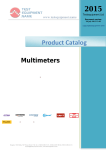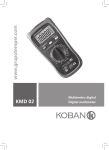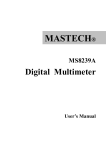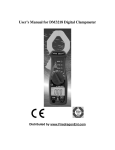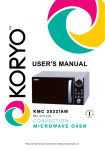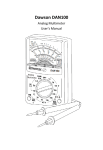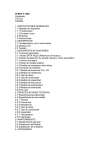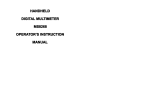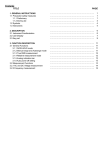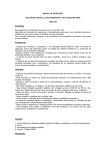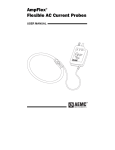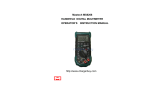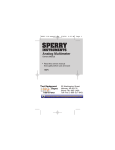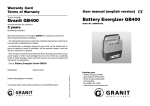Download Mastech MS8264
Transcript
Mastech
MS8264
User's Manual
GENERAL INSTRUCTIONS
This instrument complies with IEC 1010-1 (61010-1@IEC: 2001), CAT. II 1000V and CAT. III 600V
overvoltage standards. See Specifications.
To get the best service from this instrument, read carefully this user's manual and respect the detailed
safety precautions.
International symbols used on the Meter and in this manual are explained in chapter 1.1.3
Precautions safety measures
1.1.1 Preliminary
* Measurement category III is for measurements performed in the building installation.
NOTE: Examples are measurements on distribution boards, circuit-breakers, wiring, including cables,
bus-bars, junction boxes, switches, socket-outlets in the fixed installation, and equipment for industrial
use and some other equipment, for example, stationary motors with permanent connection to the fixed
installation.
* Measurement category II is for measurements performed on circuits directly connected to the low
voltage installation.
NOTE: Examples are measurements on household appliances, portable tools and similar equipment.
* Measurement category I is for measurements performed on circuits not directly connected to MAINS.
NOTE: Examples are measurements on circuits not derived from MAINS, and specially protected
(internal) MAINS derived circuits. In the latter case, transient stresses
are variable; for that reason, requires that the transient withstand capability of the equipment is made
known to the user.
* When using this Multimeter, the user must observe all normal safety rules concerning:
― protection against the dangers of electric current.
― protection of the Multimeter against misuse.
* For your own safety, only use the test probes supplied with the instrument. Before use, check that they
are in good condition.
1.1.2 During use
* If the meter is used near noise generating equipment, be aware that display may become unstable or
indicate large errors.
* Do not use the meter or test leads if they look damaged.
* Use the meter only as specified in this manual; otherwise, the protection provided by the meter may be
impaired.
* Use extreme caution when working around bare conductors or bus bars.
* Do not operate the meter around explosive gas, vapor, or dust.
* Verify a Meter's operation by measuring a known voltage. Do not use the Meter if it operates abnormally.
Protection may be impaired. When in doubt, have the Meter serviced.
* Uses the proper terminals, function, and range for your measurements.
* When the range of the value to be measured is unknown, check that the range initially set on the
multimeter is the highest possible or, wherever possible, choose the autoranging mode.
* To avoid damages to the instrument, do not exceed the maximum limits of the input values shown in the
technical specification tables.
* When the multimeter is linked to measurement circuits, do not touch unused terminals.
* Caution when working with voltages above 60Vdc or 30Vac rms. Such voltages pose a shock hazard.
* When using the probes, keep your fingers behind the finger guards.
* When making connections, connect the common test lead before connecting the live test lead; when
disconnecting, disconnect the live test lead before disconnecting the common test lead.
* Before changing functions, disconnect the test leads from the circuit under test.
* For all dc functions, including manual or auto-ranging, to avoid the risk of shock due to possible
improper reading, verify the presence of any ac voltages by first using the ac function. Then select a dc
voltage range equal to or greater than the ac range.
* Disconnect circuits power and discharge all high-voltage capacitors before testing resistance, continuity,
diodes, or capacitance.
* Never perform resistance or continuity measurements on live circuits.
* Before measuring current, check the meter's fuse and turn off power to the circuit before connecting the
meter to the circuit.
* In TV repair work, or when carrying out measurements on power switching circuits, remember that high
amplitude voltage pulses at the test points can damage the multimeter. Use of a TV filter will attenuate
any such pulses.
* Use the 9V NEDA battery, properly installed in the Meter's battery case, to power the Meter.
* Replace the battery as soon as the battery indicator (
) appears. With a low battery, the Meter
might produce false readings that can lead to electric shock and personal injury.
* Do not measure voltages above 600V in Category III, or 1000V in Category II installations.
* Do not operate the Meter with the case (or part of the case) removed.
1.1.3 Symbols:
Symbols used in this manual and on the instrument:
Caution: refer to the instruction manual.
Incorrect use may result in damage to
the device or its components.
~
AC (Alternating Current)
DC (Direct Current)
Earth ground
Double insulated
Fuse
Conforms to European Union directives
1.1.4 Instructions
* Remove test leads from the Meter before opening the Meter case or battery cover.
* When servicing the Meter, use only specified replacement parts.
* Before opening up the instrument, always disconnect from all sources of electric current and make sure
you are not charged with static electricity, which may destroy internal components.
* Any adjustment, maintenance or repair work carried out on the meter while it is live should be carried
out only by appropriately qualified personnel, after having taken into account the instructions in this
present manual.
* A "qualified person" is someone who is familiar with the installation, construction and operation of the
equipment and the hazards involved. He is trained and authorized to energize and de-energize circuits
and equipment in accordance with established practices.
* When the instrument is opened up, remember that some internal capacitors can retain a dangerous
potential even after the instrument is switched off.
* If any faults or abnormalities are observed, take the instrument out of service and ensure that it cannot
be used until it has been checked out.
* If the meter is not going to be used for a long time, take out the battery and do not store the meter in
high temperature or high humidity environment.
Protection mechanisms
* Fused by the resettable fuse (F200mA/250V) during capacitance, temperature, mA and hFE
measurements.
* A PTC resistor protects against permanent overvoltages of up to 380V during resistance, Frequency,
continuity and diode test measurements.
2. DESCRIPTION
2.1 Instrument Familiarization
1
2
3
4
1. LCD display
2.2 LCD Display
2. Keypad 3. Rotary switch
4. Terminals
See Table 1 indicated for information about the LCD display.
Figure 1.Display
Table 1. Display Symbols
Symbol
Meaning
The battery is low.
Warning: To avoid false
readings, which could lead to
possible electric shock or personal
injury, replace the battery as soon as
the battery indicator appears.
Indicates negative readings.
Indicator for ac voltage or current.
AC
voltage
and
current
are
displayed as the average of the
absolute
value
of
the
input,
calibrated to indicate the equivalent
rms value of a sine wave.
Indicator for dc voltage or current.
The Meter is in the Diode Test mode
Table 1. Display Symbols (continued)
The Meter is in the Continuity Check
mode.
The Meter is in the Data Hold mode
℃:
℃ or ℉
Celsius
scale. The
unit
of
temperature.
℉: Fahrenheit scale.
V, mV
V:
Volts. The unit of voltage.
m
Millivolt. 1x10-3 or 0.001 volts.
V:
A:
Amperes (amps). The unit of
m
current.
A, mA,
A:
Milliamp.
(A
(A
amperes.
:
Microamp. 1x10-6 or 0.000001
amperes
1x10-3
or
0.001
(, k(, M(
kHz
(:
Ohm. The unit of resistance.
k(:
Kilohm. 1x103 or 1000 ohms.
M
Megohm. 1x106 or 1,000,000
(:
ohms.
K
Kilohertz. 1x103 or 1000 hertz.
H
z:
(F, nF
F:
Farad. The unit of capacitance.
(F
Microfarad.1x10-6 or 0.000001
:
farads.
n
Nanofarad.
F:
0.000000001 farads.
1x10-9
or
2.3 Keypad
See Table 2 indicated for information about the keypad operations.
Table 2. Keypad
Key
Function
ON/O
Any
FF
position
HOLD
Any
Operation performed
switch
turn the meter on or
off
switch
position
Press HOLD to enter
and exit the Data
Hold mode.
LIGH
Any
T
position
switch
Press LIGHT to turn
the
backlight
on.
about
5
After
seconds,
the
backlight is auto-off.
2.4 Terminals
See Table 4 indicated for information about the terminals.
Table 4. Terminals
Termi
Description
nal
Return terminal for all measurements.
COM
( Receiving the black test lead or the
“com” plug of the special multi-function
socket)
V(
Hz
diode and continuity measurements.
(Receiving the red test lead)
℃mA
hF
E
Input for voltage, resistance, frequency,
Input for capacitance, Temperature,
hFE and 0.001mA to 200mA current
measurements. ( Receiving the red
test lead or the “+” plug of the special
multi-function socket)
Input
10A
for
200mA to
10A current
measurements. (Receiving the red test
lead)
2.5 Accessories
Delivered with the multimeter:
( User's manual
One piece
( Test leads
One piece
( Carry case
One piece
(
"K"
type
bead
One piece
Multi-function
One piece
Thermocouple
(
Special
socket
3. FUNCTION DESCRIPTION
3.1 General Functions
3.1.1 DATA HOLD mode
Data Hold mode makes the meter stop updating the display. Data Hold function can be cancelled by
changing the measurement mode, or push HOLD key again.
To enter and exit the Data Hold mode:
1. Press HOLD key. Fixes the display on the current value,
is displayed.
2. A second short press returns the meter to normal mode.
3.1.2 Battery Saver
Turn on the meter. And then The Meter will be turned off automatic after approx. 30 minutes.
3.2 Measurement Functions
3.2.1 AC and DC Voltage measurement
To avoid electrical shock and/or damage to
the instrument, do not attempt to take any
voltage measurement that might exceeds
1000Vdc or 750Vac rms.
To avoid electrical shock and/or damage to
the instrument, do not apply more than
1000Vdc or 750Vac rms between the
common terminal and the earth ground.
Voltage is the difference in electrical potential between two points.
The polarity of ac (alternating current) voltage varies over time; the polarity of dc (direct current) voltage
is constant.
The Meter's DC voltage ranges are 200.0mV, 2.000V, 20.00V, 200.0V and 1000V;AC voltage ranges are
2.000V, 20.00V, 200.0V and 7500V.
To measure ac or dc voltage:
1. Set rotary switch to the proper range.
2. Connect the black and red test leads to the COM and V terminals respectively.
3. Connect the test leads to the circuit being measured
4. Read the displayed value. The polarity of red test lead connection will be indicated when making a
DCV measurement.
NOTE:
( Unstable display may occur especially at DC200mV and AC2V ranges, even though you do not put test
leads into input terminals, in this case, if an erroneous reading is suspected, short the V terminal and the
COM terminal, and make sure the zero display.
3.2.2 Resistance measurement
To avoid electrical shock and/or damage
to the instrument, disconnect circuit power
and discharge all high-voltage capacitors
before measuring resistance.
Resistance is an opposition to current flow.
The unit of resistance is the ohm (().
The Meter's resistance ranges are 200.0(, 2.000k(, 20.00k(, 200.0k(, 2.000M(, 20.00M( and 200.0M(.
To measure resistance:
1. Set the rotary switch to proper range.
2. Connect the black and red test leads to the COM and ( terminals respectively.
3. Connect the test leads to the circuit being measured and read the displayed value.
Some tips for measuring resistance:
( The measured value of a resistor in a circuit is often different from the resistor's rated value. This is
because the Meter's test current flows through all possible paths between the probe tips.
( In order to ensure the best accuracy in measurement of low resistance, short the test leads before
measurement and memory the test probe resistance in mind. This necessary to subtract for the
resistance of the test leads.
( The resistance function can produce enough voltage to forward-bias silicon diode or transistor junctions,
causing them to conduct. To avoid this, do not use the 40M( range for in-circuit resistance
measurements.
( On 20M( and 200M( ranges, the meter may take a few seconds to stabilize reading. This is normal for
high resistance measuring.
( On 200M( range, the display is approx. 10 digits when test leads are shorted. These 10 digits have to be
subtracted from measuring results. For example, when measuring 100 M( resistance, the reading will be
101.0 and the correct measuring result should be 101.0-1.0=100.0 M(.
( When the input is not connected, i.e. at open circuit, the figure "1" will be displayed for the overrange
condition.
3.2.3 Diode Test
To avoid electrical shock and/or damage to
the instrument, disconnect circuit power
and discharge all high-voltage capacitors
before testing diodes.
Use the diode test to check diodes, and other semi- conductor devices. The diode test sends a current
through the semiconductor junction, and then measures the voltage drop across the junction; a good
silicon junction drops between 0.5V and 0.8V.
To test a diode out of a circuit:
1. Set the rotary switch to
range.
2. Connect the black and red test leads to the COM and
terminals respectively.
3. For forward-bias readings on any semiconductor component, place the red test lead on the
component's anode and place the black test lead on the component's cathode.
4. The meter will show the approx. forward voltage of the diode. If the test lead connection is reversed,
only figure "1" displayed.
In a circuit, a good diode should still produce a forward bias reading of 0.5V to 0.8V; however, the
reverse-bias reading can vary depending on the resistance of other pathways between the probe tips.
3.2.4 Continuity Check
To avoid electrical shock and/or damage
to the instrument, disconnect circuit power
and discharge all high-voltage capacitors
before testing for Continuity.
Continuity is a complete path for current flow.
The beeper sounds if a circuit is complete. These brief contacts cause the Meter to emit a short beep.
To test for continuity:
1. Set the rotary switch to
range.
2. Press the yellow key twice to activate Continuity Check.
3. Connect the black and red test leads to the COM and ( terminals respectively.
4. Connect the test leads to the resistance in the circuit being measured.
5. When the test lead to the circuit is below approx. 30(, a continuous beeping will indicate it.
Note:
( Continuity test is available to check open/short of the circuit.
3.2.5 Capacitance measurement
To avoid electrical shock and/or damage
to the instrument, disconnect circuit power
and discharge all high-voltage capacitors
before measuring capacitance. Use the dc
voltage function to confirm that the
capacitor is discharged.
Capacitance is the ability of a component to store an electrical charge.
The unit of capacitance is the farad (F). Most capacitors are in the nanofarad to microfarad range.
The Meter's capacitance ranges are 20.00nF, 200.0nF, 2.000(F, and 20.00(F.
To measure capacitance:
1. Set the rotary switch to proper range.
2. Connect the black and red test leads to the COM and
terminals respectively (or you can measure
the capacitance by using the special Multi-Function Socket).
3. Connect the test leads to the capacitor being measured and read the displayed value.
Some tips for measuring capacitance:
( The meter may take a few seconds to stabilize reading. This is normal for high capacitance measuring.
( To improve the accuracy of measurements less than 20nF, subtract the residual capacitance of the
Meter and leads.
3.2.6 Transistor measurement
To avoid electrical shock and/or damage
to the instrument, do not apply more than
250Vdc or 250Vac rms between the hFE
terminal and the COM terminal.
1. Set the rotary switch to hFE range.
2. Connect the “com” plug and “+” plug of the special multi-function socket to the COM and hFE
terminals.
3. Determine whether the transistor to be tested is NPN or PNP type and locate the Emitter, Base and
Collector leads.
4. Insert leads of the transistor into proper holes of the special multi-function socket.
5. The meter will show the approx. hFE value at test condition of base current 10μA and Vce 2.8V.
3.2.7 Frequency measurement
Do not measure Frequency on high voltage
(>380V) to avoid electrical shock hazard
and/or damage to the instrument.
Frequency is the number of cycles a voltage or current signal completes each second.
To measure frequency:
1. Set the rotary switch to 20kHz range.
2. Connect the black and red test leads to the COM and Hz terminals respectively.
3. Connect the test leads to the circuit being measured
4. Read the displayed value.
3.2.8 Temperature measurement
To avoid electrical shock and/or damage to
the instrument, do not apply more than
250Vdc or 250Vac rms between the ℃
terminal and the COM terminal.
To avoid electrical shock, do not use this
instrument
when
voltages
at
the
measurement surface exceed 60v dc or
24v rms. Ac.
To avoid damage or burns. Do not make
temperature measurements in microwave
ovens.
To measure temperature:
1. Set the rotary switch to ℃ range and the LCD will show the current environment temperature.
2. Connect the “com” plug and “+” plug of the special multi-function socket to the COM and hFE
terminals.
3. Insert ‘K’ type thermocouples into the special multi-function socket,Takings care to observe the correct
polarity.
4. Touch the object with the thermocouple probe for measurement.
5. Read the stable reading from LCD.
3.2.9 Current measurement
To avoid damage to the Meter or injury if
the fuse blows, never attempt an in-circuit
current
measurement
where
the
open-circuit potential to earth is greater
than 250V.
To avoid damage to the meter, check the
meter's fuse before proceeding. Use the
proper terminals, function, and range for
your measurement. Never place the test
leads in parallel with a circuit or component
when the leads are plugged into the current
terminals.
Current is the flow of electrons through a conductor.
The Meter's DC current ranges are 20.00mA, 200.0mA and 10.00A;AC current ranges are 2.000mA,
200.0mA and 10.00A.
To measure current:
1. Turn off the power of the measured circuit. Discharge all the high voltage capacitors.
2. Set the rotary switch to the proper range.
3. Connect the black test lead to the COM terminal and the red test leads to the mA terminal for a
maximum of 200mA. For a maximum of 10A, move the red test lead to the 10A terminal.
4. Break the circuit path to be tested.
Connect the black test lead to the more negative side of the break; connect the red test lead to the more
positive side of the break. (Reversing the leads will give a negative reading, but will not damage the
Meter.)
5. Turn on the power of the measured circuit, and then read the display. Be sure to note the
measurement units at the right side of the display (mA or A). When only the figure "1" displayed, it
indicates overrange situation and the higher range has to be selected.
6. Turn off the power of the measured circuit and discharge all the high voltage capacitors. Remove the
test leads and recover the measured circuit.
4 TECHNICAL SPECIFICATIONS
4.1 GENERAL SPECIFICATIONS
( Environment conditions:
1000V CAT. II and 600V CAT. III
Pollution degree: 2
Altitude < 2000m
Operating temperature:
0~40℃, 32℉~122℉(<80% RH, <10℃ noncondensing)
Storage temperature:
-10~60 ℃, 14℉~140℉(<70% RH, battery removed)
( Temperature Coefficient:
0.1((specified accuracy) / ℃ (<18℃ or >28℃)
( MAX. Voltage between terminals and earth ground:
750V AC rms or 1000V DC.
( Fuse Protection: mA: Resettable fuse (F200mA/250V)
( Sample Rate: 3 times/sec for digital data.
( Display: 3 1/2 digits LCD display. Automatic indication of functions and symbols.
( Over Range indication: LCD will display "1".
( Low battery indication:
The "
" is displayed when the battery is under the proper operation range.
( Polarity indication: "(" displayed automatically.
( Power source: 9V
( Battery type: NEDA 1604, 6F22, or 006P.
( Dimensions: 195(L)(92(W)(55(H) mm.
( Weight: 380g. Approx. (battery included).
4.2 Measurement specifications
Accuracy is specified for one year after calibration, at operating temperatures of 18℃ to 28℃, with
relative humidity at 0% to 75%.
Accuracy specifications take the form of: ±(% of Reading + Number of Least Significant Digits)
4.2.1 DC Voltage
Rang
Resolutio
e
n
200m
0.1mV
V
2V
Accuracy
±(0.5% of rdg +1 digit)
1mV
20V
10mV
200V
100mV
1000
1V
±(0.8% of rdg +2 digits)
V
Input impedance: 10M(
Max. input voltage: 250Vdc or ac rms for 200mV range and 1000Vdc or 750V ac rms for other ranges,
4.2.2 AC Voltage
Range
Resoluti
Accuracy
on
2V
1mV
20V
10mV
200V
100mV
750V
1V
±(0.8% of rdg +3 digits)
±(1.2% of rdg +3 digits)
Input impedance: 10M(
Max. input voltage: 250Vdc or ac rms for 200mV range and 1000Vdc or 750V ac rms for other ranges,
Frequency Range: 40Hz-200Hz for 750V range, 40Hz-400Hz for other ranges.
Response: Average, calibrated in rms of sine wave
4.2.3 Frequency
Range
Resoluti
Accuracy
on
20kHz
10 Hz
±(1.5% of rdg+5 digits)
Overload protection: 380V dc or 380V ac rms.
Input Voltage range: 200mV-10V ac rms
4.2.4 Resistance
Rang
Resolut
Accuracy
e
ion
200(
0.1(
2k(
1(
20k(
10(
200k(
100(
2M(
1k(
20M(
10k(
±(1.0% of rdg+2 digits)
200M(
0.1M(
±[5.0% of (rdg-10digits) +10
±(0.8% of rdg+3 digits)
±(0.8% of rdg+1 digit)
digits]
Overload protection: 380V dc or 380Vac rms.
Open Circuit Voltage: Less than 700mV.
4.2.5 Diode
Rang
Resoluti
e
on
1mV
Function
Display
read
approx.
forward voltage of diode
Forward DC Current: approx. 1mA
Reversed DC Voltage: approx. 2.8V
Overload protection: 380Vdc or 380Vac rms.
4.2.6 Audible continuity
Rang
Continuity beeper
e
≤30(
Open circuit voltage: Less than 700mV.
Overload protection: 380Vdc or 380Vac rms.
4.2.7 Transistor
Ran
Description
Test Condition
ge
Display
hFE
read
Base
Current
approx. HFE value
approx.
(0-1000)
Vce approx. 2.8V.
transistor
of
10μA,
under
test (all type).
4.2.8 Temperature
Range
Resoluti
Accuracy
on
-20℃~0℃
±(5.0%
of
rdg+4
of
rdg+3
digits)
1℃~400℃
1℃
401℃~1000
℃
±(1.0%
digits)
±2.0% of rdg
Overload protection: Resettable fuse (F200mA/250V).
* Temperature specifications do not include thermocouple errors.
4.2.9 Capacitance
Range
Resolutio
Accuracy
n
2nF
1pF
20nF
10pF
200nF
0.1nF
2(F
1nF
20(F
10nF
±(4.0% of rdg+3 digits)
Overload protection: Resettable fuse (F200mA/250V).
4.2.10 DC Current
Range
Resolutio
n
20mA
10(A
200mA
0.1mA
10A
10mA
Accuracy
±(1.5% of rdg+1 digit)
±(2.0% of rdg+5 digits)
Overload protection: Resettable fuse (F200mA/250V). 10A range unfused
Max. input current: 200mA dc or 200mA ac rms for mA range, 10A dc or 10A ac rms for 10A ranges.
For measurements>5A, 4 minutes maximum ON to measure 10 minutes OFF; Above 10A unspecified.
4.2.11 AC Current
Range
Resolutio
n
Accuracy
2mA
1(A
±(1.0% of rdg+3 digits)
200mA
0.1mA
±(1.8% of rdg+3 digits)
10A
10mA
±(3.0% of rdg+7 digits)
Overload protection: Resettable fuse (F200mA/250V). 10A range unfused.
Max. input current: 200mA dc or 200mA ac rms for mA range, 10A dc or 10A ac rms for 10A ranges.
For measurements>5A, 4 minutes maximum ON to measure 10 minutes OFF; Above 10A unspecified.
Frequency Range: 40Hz-400Hz
Response: Average, calibrated in rms of sine wave
5. MAINTENANCE
Do not attempt to repair or service your Meter unless you are qualified to do so and have the relevant
calibration, performance test, and service information.
5.1 General Maintenance
To avoid electrical shock or damage to the
meter, do not get water inside the case.
Remove the test leads and any input
signals before opening the case
Periodically wipe the case with a damp cloth and mild detergent. Do not use abrasives or solvents.
Dirt or moisture in the terminals can affect readings.
To clean the terminals:
( Turn the meter off and remove all test leads.
( Shake out any dirt that may be in the terminals.
( Soak a new swab with a cleaning and oiling agent (such as WD-40).
( Work the swab around in each terminal. The oiling agent insulates the terminals from moisture-related
contamination.
5.2 Battery replacement
To avoid false readings, which could lead to
possible electric shock or personal injury,
replace the battery as soon as the battery
indicator (
) appears.
Before replacing the battery, disconnect test
leads and/or any connectors from any circuit
under test, turn the meter off and remove
test leads from the input terminals.
To replace the battery (see Figure 2.):
( Turn the meter off.
( Disconnect test leads and/or any connectors from the terminals.
( Use a screwdriver to unscrew the two screws secured on the battery cover.
( Take out the battery cover from the meter.
( Remove the used batteries.
( Replace with the new 9V batteries (6F22).
( Rejoin the battery cover and secure by the two screws.
Battery cover
9V Battery
Figure 2. Battery and Fuse Replacement
CAUTION
Using this appliance in an environment with a strong radiated radio-frequency electromagnetic field
(approx. 3V/m), may influence its measuring accuracy. The measuring result can be strongly deviating
from the actual value.















